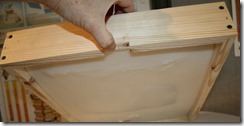Bees In The Fall
Bees In The Fall
When the weather's nice I enjoy walking around my hives and just watching my bees. Every fall I notice dead bees on the bottom board entrance. Sometimes you see this the day after you inspect a hive. In the fall they get rid of the drones, the male bee. Drones are useful during the spring and summer to mate with virgin queens. But in the fall queen rearing is over. It is too late in the year to raise new queens so they get rid of their male population.
Occasionally a few drones may overwinter, but usually a colony doesn’t overwinter with drones because drones are not workers and are heavy consumers of precious winter stores of food. A colony must be very protective of their winter pollen and honey or they might starve in March or sooner.
 You will start seeing dead bees around your entrance but don’t panic. Just double check to be sure they are drones. A drone has a larger body and their eyes are larger and touch in the middle. Also, you may notice worker bees will pull out drone pupae. Before the drone can even mature, the house bees open up the cells and drag them out, making more room to store resources or for the queen to lay eggs for winter bees. Winter bees can live 6-9 months.
You will start seeing dead bees around your entrance but don’t panic. Just double check to be sure they are drones. A drone has a larger body and their eyes are larger and touch in the middle. Also, you may notice worker bees will pull out drone pupae. Before the drone can even mature, the house bees open up the cells and drag them out, making more room to store resources or for the queen to lay eggs for winter bees. Winter bees can live 6-9 months.
A summer worker bee only lives about 40 days. This is important to remember because as we will point out further in this lesson, mites can shorten your colony's longevity by one half.
 In the fall we get phone calls about funny smells from the hive. This is the smell of aster honey being cured by the bees. Again, stay calm and enjoy this fall odor from the hive. Can you harvest goldenrod honey? Yes, at first the taste may be noticeably different than clover, but as the honey sits in buckets or is mixed with clover the taste and smells is minimized.
In the fall we get phone calls about funny smells from the hive. This is the smell of aster honey being cured by the bees. Again, stay calm and enjoy this fall odor from the hive. Can you harvest goldenrod honey? Yes, at first the taste may be noticeably different than clover, but as the honey sits in buckets or is mixed with clover the taste and smells is minimized.
If you are concerned about harvesting funny tasting fall honey simply open up the hive, and poke your finger in a frame of sealed honey and evaluate the taste. If you can’t stand it, leave it for the bees. They’ll enjoy it. If you like it, make sure you leave 80 pounds of honey on the hive if you live in north and harvest the rest.
Now, can fall really be a dangerous and challenging time for your hives? Yes, here’s 6 reasons why:
1. Accidently killing the queen when harvesting honey frames.
In the fall, beekeepers are harvesting honey. The risk of killing the queen or accidently removing her in a super of honey is greatly increased. Before I harvest my supers, I find my queen and temporarily cage her so that I can work my hives fast in the fall to prevent robbing. Then I release her back into her hive after I’m finished working my hive. Remember, the drones are dead. So if you kill your queen they cannot raise a replacement queen because she cannot mate with drones. If you see a queen cell, it just means you’ll get stuck with a virgin queen all winter. She will never mate if she does not mate after she is 21 days old. She will not mate in the spring if she failed to take a mating flight late in the year.
2. Failure to keep mice out of the hive.
 Mice are licking their chops, and their mouths are watering wanting to consume your bees. As soon as nights turn cold mice move in. We are already having nights in the mid 40s. Mice are looking for warm places and your hive is a perfect place. The warmth produced by the bees, fresh pollen and honey and bees to munch on is perfect for mice. NOW IS THE TIME to take action. This week!! Don’t delay. Reduce your entrances. Our hives come complete with entrance reducers. Set it to the smallest opening.
Mice are licking their chops, and their mouths are watering wanting to consume your bees. As soon as nights turn cold mice move in. We are already having nights in the mid 40s. Mice are looking for warm places and your hive is a perfect place. The warmth produced by the bees, fresh pollen and honey and bees to munch on is perfect for mice. NOW IS THE TIME to take action. This week!! Don’t delay. Reduce your entrances. Our hives come complete with entrance reducers. Set it to the smallest opening.
3. Harvesting too much honey. It’s so tempting to keep taking more and more honey off the hive. It looks so nice in your bottles with your fancy label. Your customers are throwing tens and twenties at you for that precious gold. But if you harvest too much, your bees will not have enough to tide them over through late winter and early spring. I try and leave one full super on each hive for winter.
 But I also place extra insurance on my hive by placing our Winter-Bee-Kinds on my hives all winter. This ensures me that they will not run out of food. We will begin shipping these in November in the order that orders were placed.
But I also place extra insurance on my hive by placing our Winter-Bee-Kinds on my hives all winter. This ensures me that they will not run out of food. We will begin shipping these in November in the order that orders were placed.
You need to leave 60-80 pounds of honey on the hive for winter. Don’t be too greedy.
While golden rod keeps bees all covered with pollen, pollen baskets packed and honey stomachs full, it will soon stop.
4. Fall starvation. This is different than taking too much honey. Some falls have been proceeded by a long dearth. Bees eat through their winter stores during fall and have nothing in the winter. That’s why I feed my bees in the fall. Once I see that the nectar flow has ended I start feeding my bees sugar water and pollen patties. They will for sure need fed after the first frost kills all the flowers. I run our Burns Bees Feeding System that has two jar holes and one pollen patty hole. All holes are protected with screen so you can change your jars and patty without bees getting out. I place 2:1 in one jar to help the bees cure it into “honey.” The other jar has 1:1 so the bees can consume it and use it for brood stimulation to help me build up my brood of spring bees. Feed! Feed! Feed!
5. Mites are shifting from drones to workers and increasing in number, spreading viruses in your colony. If you think you do not have varroa mites, you are wrong. All colonies have mites. In our winter classes we actually teach you how to test for mites and calculate your hive’s percentage of infestation. Do not think you do not have mites simply because you do not see any. You have them! Get rid of them. Mites prefer drones, but now that drones are being killed, mites are now parasitizing your worker brood. And when mites have viruses, they spread them to worker bees which shortens the life of that winter bee from 6-9 months to 4-6 months. That means a bee born in October would have lived until May or June will now only live to January or February. Sound familiar? Do nothing to get rid of mites and your hive will probably not make it to see March or April.
6. Improper inspection can cause the hive to be robbed out. You go out to inspect your hive or remove honey supers. There’s no nectar flow. You separate your boxes stacking them around your hive. Pretty soon you seem engulfed by robber bees swarming around you hive. Those desperate fall bees have gotten a sniff of honey from your opened hive and they have plotted a course to rob it out.
I just made a new video on how to make these inspections in the fall. The trick is to keep all boxes covered that are separate from the colony. Use extra top covers to encase open boxes while you inspect. Don’t keep your hive open in the fall, during a dearth for more than 10 minutes. Do NOT leave your queen excluder on for winter. Place your entrance reducer on the hive before you start your inspection.
Final fall tips:
Never use entrance feeders at the front of the hive in the fall. It will cause robbing.
If you break the top propolis seal after it turns cold use a heavy rock or brick to prevent the top from blowing off.
Prepare some sort of wind break for winter.
Combine weak hives with large ones. Kill the queen in the weak hive and place newspaper between the different combined boxes. The bees will eat through the paper and by that time they will get along.
Wouldn't it be nice to have a certified master beekeeper on the other end of the phone or email whenever you had a question. I started my new membership program and members are loving it. Beekeepers around the country have jumped on board. We still have room for more. Click Here For More Information.

